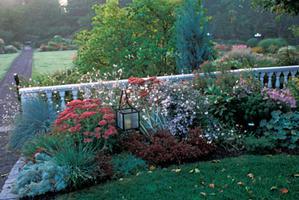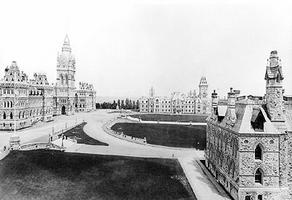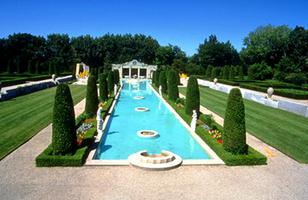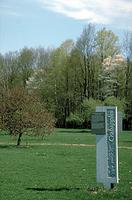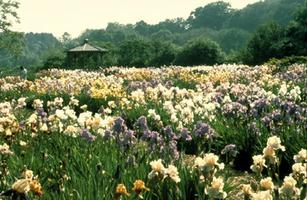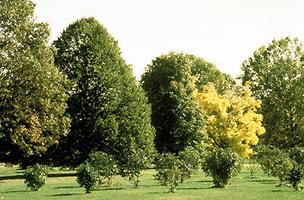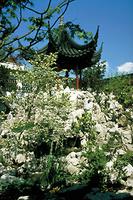Historic Gardens
Gardens can be viewed, studied and understood as cultural landscapes. Their aesthetic, horticultural, historic and environmental richness as well as their evocative power excite wonder and delight. At the same time, historic gardens present impressive challenges to scholars interested in studying them and to public and private groups in society interested in recognizing and protecting them. The 1980s and 90s have seen a renewed interest in historic gardens among researchers, bureaucrats and members of the general public.
Florence Charter
In 1981 the International Committee of Historic Gardens (ICOMOS-IFLA) developed the Florence Charter to protect historic gardens. This important document, adopted in 1982, furnished a new definition of historic gardens and laid out general principles to guide their upkeep, conservation and restoration. It defined the historic garden as "an architectural and horticultural composition of interest to the public from the historical or artistic point of view. As such, it is to be considered as a monument." Further, according to the Charter, an historic garden is "an architectural composition whose constituents are primarily horticultural and therefore alive, which means they are perishable and renewable." A garden's architectural features are represented in its plan, the contours of the terrain, the formations of the vegetation (species, mass, play of colour, spacing and respective height), its constructed or decorative elements and moving or still water. Examples of historic gardens can be found in many scales, from the modest domestic garden to the landscaped park.
A historic garden is more than a composition of vegetation. Apart from its physical elements (earth, water, rocks, plants, shrubs and trees), it can include buildings, shelters or sculptures. Over time, it will alter in appearance and probably serve diverse functions. It may be perceived as incorporating and projecting intangible qualities drawn from its surroundings - often referred to as genius loci or spirit of the place. Like all gardens, historic gardens are marked by seasonal changes in form, colour and scent. To these and other natural changes must be added transformations brought about over the years by human hand.
Besides being appreciated for their aesthetic and artistic qualities, historic gardens gain interest in relation to factors such as style, type, garden tradition, horticultural specifics (age, variety, state, provenance or rarity of the plants and trees), ecology, historical associations, and the importance of their designer.
Canada's historic gardens reflect aspects of the history, climate and geography of the country. For purposes of discussion they can be categorized first by function (public parks, horticultural gardens, institutional gardens, residential gardens and specialized gardens). Secondly, they can be understood in relation to the one or more styles they represent.
Functions of Gardens
Public parks, found in population centres such as towns and cities and accessible to the public, are usually ornamented spaces with lawns, flower beds and trees. Intended primarily for recreational use, public parks offer resting-places, paths and sometimes play areas. They vary in size from a small town square to a large tract of land and they often accommodate official functions. The Public Gardens of Halifax are a good example. Conceived by Richard Power, landscape gardener, they were opened to the public in 1875. Power had incorporated earlier gardens developed by the Nova Scotia Horticultural Society from 1837 as well as a municipal garden created in 1867. Today the Public Gardens of Halifax consist of winding paths, flower beds in geometric form surrounded by grass, borders of both perennials and annuals, statues, fountains and a bandstand, the latter attesting to the Victorian taste for open air musical performances.The principal function of horticultural gardens is scientific research and public education, although their recreational and aesthetic qualities are often featured. Into this category fall experimental farms (where crop research, agricultural utilization studies and the breeding and testing of ornamental plants for hardiness are carried out), nurseries (where young plants destined for thinning or for use as stock are grown), botanical gardens (where plant species are cultivated, classified and identified for methodical study) and arboreta (nurseries devoted to the experimental cultivation of trees of different species). The Royal Botanical Gardens of Hamilton, established by provincial legislation in 1941 but with an unofficial history dating back to the 1920s when the city began acquiring land for it, is an example of the horticultural garden. It consists of vast landscaped gardens including a notable collection of irises, a rock garden, a rose garden, an arboretum (including a lilac garden), a children's garden, a garden with medicinal plants, natural areas for explaining ecosystems, as well as a programme of courses and research. Its activities are principally directed to scientific research, teaching, public education and also amusement.
The institutional garden is a pleasure garden whose function is to complete or enhance public buildings such as hotels, hospitals and factories as well as religious or administrative buildings. Its raison d'être is often directly connected with the building's function but it also provides an aesthetic complement to the architecture. In the first decades of the twentieth century, gardens were laid out next to schools so that the children could learn the rudiments of gardening. These gardens had a pedagogical function. In the same period, almost everywhere in the country, gardens were laid out next to small railway stations. They served to beautify the sites and, particularly in the West, to promote the development of new regions.
At SAINT JOSEPH'S ORATORY of Mount Royal, in Montréal, a small garden was designed near the Basilica by landscape architect Frederick G. TODD from 1943-46. An impressive Way of the Cross, with monumental stone sculptures, has been placed in this garden.
The grounds laid out between 1875 and 1879 by landscape artist Calvert Vaux in front of the Parliament Buildings in Ottawa were designed to reinforce the institution of government. The building's architects, conscious of the importance of the project, were concerned from the beginning that the grounds be in harmony with the buildings. Vaux included elegant steps leading to a large terrace, a broad sweep for the arrival and departure of vehicles, along with enclosures and low walls, which lend considerable grandeur to the whole. Over time these grounds have acquired an importance derived from their association with major events in Canadian life (ceremonies, celebrations, protests); they have contributed to the symbolic value of the place.
Residential gardens have a much more private, intimate character, whether they are pleasure gardens, vegetable or kitchen gardens or even small plots of aromatic herbs laid out next to private or official residences. Maplelawn in Ottawa, built from 1831 to 1834 by William Thomson, a farmer, had an adjoining walled garden. In its early stages it was probably a kitchen garden for the domestic use of the household. In the 1940s perennial borders were laid out. Today, the garden still has the four-square layout of the beds. Often many such distinct gardens are incorporated into the formal or informal design for the grounds of one residence. For example, the W.B. MOTHERWELL HOMESTEAD in Saskatchewan, developed over time since 1883 and taking into account the local climate and the scientific expertise of the time, contained various pleasure gardens, vegetable gardens, orchards and shelterbelts. RIDEAU HALL in Ottawa, with its fine perennial gardens, is an example of a pleasure garden situated in the pastoral setting of an official estate. The Estate of the Lieutenant-Governor in Victoria, BC, includes vast grounds that started to be developed in the early 20th century. They include constantly evolving picturesque gardens, a shaded pond and a precious Garry oak ecosystem.
Specialized gardens, often designed in response to changing fashions, exclusively feature a single physical element such as water, rocks or roses, or a structural element such as greenhouses, glass-walled rooms or statues. Aquatic gardens, perennial gardens, rose gardens, sculpture gardens, zoological gardens, enclosed gardens, winter gardens, roof gardens and even greenhouses are familiar examples of specialized gardens. A notable example of this garden type is the Cascade of Times rock garden at Banff, constructed in 1935 and intended to display the geology of the Rockies.
Gardens which have been restored or re-created for their historical value and interest are another type of specialized garden. The Cataraqui estate at Sillery in Québec, for example, includes a restored garden. With the aid of historical and ethnographical research, the woodlands, gardens, greenhouses, flower borders and rockeries of this vast property have recently been redone according to the plans and concepts which, in the 1930s, inspired and guided its owners and their landscape architect, Mary Stewart.
Garden Styles
Gardens can also be classified in relation to their stylistic characteristics, where style is the expression of an aesthetic ideal, a trend, a particular taste or a form peculiar to an era or a cultural group. From one era to another overall principles of unity or variety, of rhythm, balance, proportion and scale will vary and produce recognizable stylistic layouts. In Canada, styles popular in France, England and the US have been relied on as models. However, the unique social, ecological, climatic or geographic conditions prevailing in Canada, as well as the limitations and possibilities inherent in the plant stock, have influenced Canadian versions of European and American styles.
The concept of style can rarely be rigidly applied to a garden design. In Canada, gardens exist which can be described as French, English, gardenesque, Edwardian or even wild. In some regions, particularly BC and the western provinces, the influence of Japanese and Chinese styles has been important. The influence of ethno-cultural traditions is traceable in some gardens. And, of course, gardens can encompass more than one style or present a modern interpretation of a style from the past.
In the Canadian context French-style gardens are those laid out during the age of New France in connection with political institutions or religious communities. Designed according to a regular and symmetrical plan (a square or rectangle with perpendicular axes and a focal point), these gardens had utilitarian and aesthetic functions. With its geometric plan, flower beds, walks, floral clumps and fruit trees, the garden of the Vieux-Séminaire des Sulpiciens on Notre-Dame Ouest in Montréal, dating from the late 17th century, is the best preserved of the convent gardens in that city. Though transformed several times, this garden preserves part of its original formal character, recalling the monastic gardens of Europe. It provided the religious community with fruit and vegetables, and was at the same time a place for reflection and prayer. It is divided into two parts: one for recreation (with trees and flowers) and a vegetable garden to serve practical needs.
After the British conquest in 1759, British and Loyalist settlers introduced a new approach vis-à-vis nature and landscape. In contrast to French formalism, the aesthetic theory advanced by Lancelot "Capability" Brown (1716-1785) and Humphrey Repton (1782-1818) featured natural and picturesque landscapes and was expressed in the choice of spectacular sites, contrasting forms and irregular contours. With their borders, lawns, winding paths and exotic trees, the grounds surrounding the Governor's House in St John's, Newfoundland (laid out for the most part between 1840 and 1850) illustrate this English fashion with its emphasis on picturesque effects. Likewise, the grounds developed between 1850 and 1860 by Louis-Joseph Papineau and his son Louis-Joseph Amédée around his Montebello estate on the banks of the Outaouais River in Québec feature panoramic views and the natural and rustic effects characteristic of this aesthetic fashion. Laid out in the 1870s, most likely following designs prepared by Frederick Law Olmsted, the Beechcroft estate at Roches Point in Ontario illustrates this natural approach with its vast green spaces, careful groupings of trees and judiciously chosen viewpoints.
A descendent of the picturesque ideas put forward in England by Humphrey Repton is the gardenesque style. Popular throughout the Victorian period, this style emphasizes the contrasts between the open lawn around the house and wilder and picturesque accent areas. Gardens described as gardenesque contain a great variety of flower borders and groves, fountains, urns and statues which give them an ornate character. With its statues, urns and flower borders, Lakehurst at Roches Point in Ontario illustrates this popular garden style as implemented during the second half of the 19th century in Canada. In the same spirit, the Public Gardens of Halifax, as laid out in the 1870s by Richard Power, contain exotic and indigenous trees and bushes, floral beds in geometric form, statues, urns, fountains, ponds, a bandstand and paths, creating an ensemble marked by contrasts in form and colour.
Gardens of the Edwardian period were influenced by important aesthetic trends at the beginning of the 20th century, particularly those coming from the teaching at the École des Beaux-Arts in Paris and those popularized by the City Beautiful Movement in the United States. The grounds laid out in 1913 around the SASKATCHEWAN LEGISLATIVE BUILDING in Regina, Sask, incorporate these trends. Their designer, Thomas H. Mawson, used ideas put forward by the City Beautiful Movement, the Garden City Movement and the École des Beaux-Arts in Paris to take advantage of the site's topography, introducing into it paths, gardens and recreational areas which reflect this era's taste for well-groomed, balanced and rational use of space.
Gardens designed and executed at the beginning of the 20th century under the influence of the writings of Gertrude Jekyll emphasize perennial borders, rockeries and alpine plants. The rock-garden which Mary Stewart laid out at the Cataraqui estate in Sillery in the 1930s was inspired by this approach. On a different principle, many gardens created at this time mark a nostalgic return to the past by imitating concepts developed in Italy and France in the 18th and 19th centuries.
The Parkwood estate in Oshawa, Ont, contains a series of distinct and well- identified gardens created by the landscape architects H.B and L.A. DUNINGTON-GRUBB in the 1920s in the spirit of the British and American traditions of that time: in particular a rose garden, a white garden, a garden with a sundial, a sunken garden and an Italian garden with a huge central basin of waterlilies, surrounded by formal borders and flagged walks. In 1936 John Lyle laid out another garden there, which, with its terrace, basin, six fountains and monochrome borders, offers a refined adaptation on Canadian soil of the Art Deco style.
West Coast influences on the style of gardens emanate from California and the Orient, at the same time making use of the climatic and geographic conditions prevailing in this region of the country. Architect Arthur ERICKSON's home in Vancouver (1960), for example, combines modern ideas about handling landscape with Japanese influence, at the same time creating a close relationship between the house and its garden.
The many Chinese and Japanese gardens on the West Coast are one indication of the contribution these cultures have made to BC. The Nitobe Memorial Garden at the University of British Columbia (1960, restored 1992) is an example of such a Japanese garden. Designed by Kannosuke-Mori, Professor of Traditional Landscape Architecture at Chiba University, the 2½ acre grounds include an informal stroll garden and a tea garden. The Botanical Garden of Montréal includes a Chinese garden, the Jardin du Lac de Rêve, conceived and realized in China and put together on site. In it water and stone occupy an important place. Oriental influence may also be expressed in a more subtle way when the attempt is made to re-create or evoke the spirit peculiar to such gardens; a case in point is the Japanese garden in the Butchart Gardens in Victoria in British Columbia.
Many gardens are designed by individuals or groups to perpetuate or illustrate traditions belonging to a specific ethno-cultural group. In the Kitchener/Waterloo area of Ontario, for example, people of German descent plant gardens in the style of their European forbears. These enclosed gardens are divided into four squares demarcated by two paths which cross; they contain a great variety of plants, vegetables and fruit trees and have practical, ornamental and symbolic functions.
Historic gardens are much more than a pleasant ornamental and recreational décor. They bear witness to the aesthetic, social, cultural and environmental tastes and preoccupations of a past - sometimes distant, sometimes relatively recent. By virtue of this they form an important part of our heritage, a rich heritage which should be preserved for future generations.
See also BOTANICAL GARDENS, LANDSCAPE ARCHITECTURE, RESEARCH STATIONS) .

 Share on Facebook
Share on Facebook Share on X
Share on X Share by Email
Share by Email Share on Google Classroom
Share on Google Classroom
